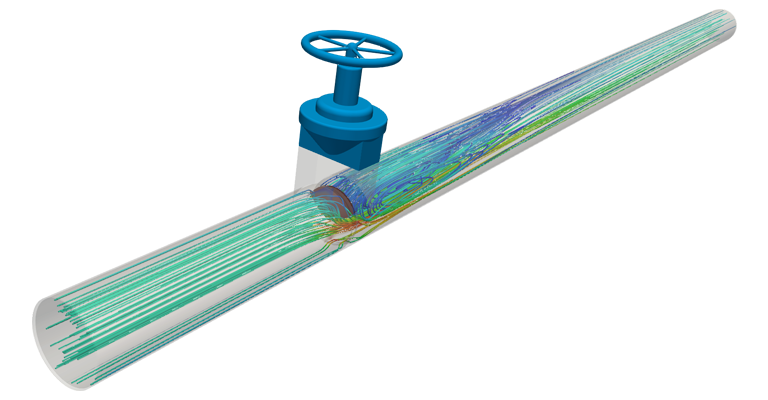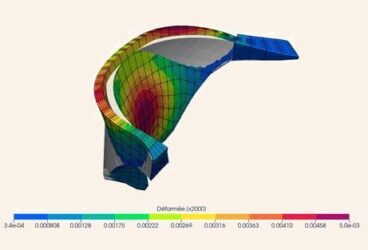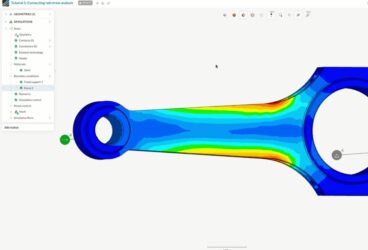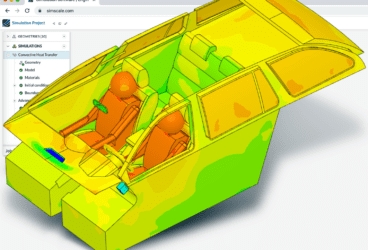OpenFOAM® is gaining growing popularity in the engineering simulation world. As an open source solver, it can be used for the majority of classical simulation problems.
It is widely known that OpenFOAM is not the most user-friendly software, however. Acknowledging its power and aiming to make OpenFOAM’s functionality easier to use, SimScale integrated it into its cloud-based simulation platform. With an easy-friendly interface that integrates various solvers including OpenFOAM, Code_Aster, and CalculiX, SimScale developed further, becoming an open ecosystem where simulation functionality, content, as well as people, are brought together in one place. SimScale is not open source, but through the Community account, engineers and designers can join free of charge and collaborate effectively with their peers.
Challenges in Classical Simulation Methods
Current simulation challenges are related to the integration and automation of simulation tools in a very complex CAE environment, including automatic geometry retrieval, surface and volume meshing, and sensitivity and optimization studies. In terms of the solver settings and user expertise, computational fluid dynamics is considerably behind finite element analysis, making the problems of software development and usability more pressing.
Range and quality of physical models, solver settings, and solution algorithms, as well as the lack of robust automatic solution control, brings considerable complexity to the user. The current state of solver development aims to produce monolithic general purpose tools, trying to tackle all physical problems for all users. These are few consequences which can arise [1]:
- Simulation software becomes exceedingly complex due to the interaction between numerous physical models, solution strategies, and solver settings. This leads to development bottlenecks and difficulties in testing and validation;
- User requirements may involve experimental material properties, additional equations in the system or coupling with multiple external packages into simulation networks;
- Monolithic software necessarily implies that for any set of physics only a small subset of functionality is being used. The impact of unused or incompatible model combinations remains, typically in unnecessary memory usage;
- A drawback of monolithic tools is the tendency to use identical discretization and numerics even when they are clearly sub-optimal, simply because they “fit into the framework”.
What is OpenFOAM?
OpenFOAM is free, offering to users the freedom to run, copy, distribute, study, change, and improve the software. OpenFOAM was developed primarily by OpenCFD Ltd in 2004 and distributed by OpenCFD Ltd and the OpenFOAM Foundation. It has a large user base across most areas of engineering and science, from both commercial and academic organizations. It has an extensive range of features to solve anything from complex fluid flows involving chemical reactions, turbulence, and heat transfer, to acoustics, solid mechanics, and electromagnetics.
OpenFOAM is first and foremost a C++ library, used primarily to create executables, known as applications. The applications fall into two categories: solvers—each of them designed to solve a specific problem in continuum mechanics—and utilities—designed to perform tasks that involve data manipulation. New solvers and utilities can be created by its users with some pre-requisite knowledge of the underlying method, physics, and programming techniques involved [2].
OpenFOAM is a collection of approximately 250 applications built upon a group of over 100 software libraries (modules). Each application performs a specific task, for example, the snappyHexMesh application that can generate meshes for complex geometries, such as for a vehicle. The simpleFoam application could then be used to simulate steady-state, turbulent, incompressible flow around the vehicle.
The main resource for OpenFOAM’s community of developers is the OpenFOAM User Guide, which
- Examines the setup of input data files for a CFD analysis. The input data includes time information (start time, end time, and time step) and controls for reading and writing data (time, format, and compression)
- Describes the setting of numerical schemes that affect accuracy and stability of a simulation. Matrix solver controls and algorithm controls are also explained that affect computational time and stability
- Includes a chapter on meshing, beginning with the mesh structure of OpenFOAM and the handling of boundaries and boundary conditions
- Includes applications that convert meshes from well-known formats into the OpenFOAM format and detailed coverage is given to the principal conversion applications (e.g., fluentMeshToFoam)
- OpenFOAM is shipped with a version of ParaView that enables the visualization of elements used commonly in CFD such as geometry surfaces, cutting planes, vector plots, and streamlines. Animations can be generated conveniently from ParaView.
In this case study, the SimScale cloud-based CAE platform was used to investigate a ducting system and optimize its performance. Download it for free to learn how.
CFD Analysis Covered by OpenFOAM
OpenFOAM is gaining considerable popularity in academic research and among industrial users, both as a research platform and a black-box CFD and structural analysis solver. The main ingredients of its design are:
- Expressive and versatile syntax, allowing easy implementation of complex physical model
- Extensive capabilities, including wealth of physical modeling, accurate and robust discretization, and complex geometry handling, to the level present in commercial CFD
- Open architecture and open source development, where complete source code is available to all users for customization and extension at no cost
OpenFOAM does not have a generic solver applicable to all cases. Instead, its users must choose a specific solver for a class of problems to solve. The solvers with the OpenFOAM distribution are in the SOLVERS directory, reached quickly by typing app at the command line. This directory is further subdivided into several directories by category of continuum mechanics, for example, incompressible flow, heat transfer, multiphase, Lagrangian, and combustion. Each solver is given a name that is descriptive.
The current list of solvers distributed with OpenFOAM is covering a wide spectrum of CFD analysis:
- ‘Basic’ CFD codes
- Incompressible flow
- Compressible flow
- Multiphase flow
- Direct numerical simulation (DNS)
- Combustion
- Particle-tracking flows
- Molecular dynamics methods
- Direct simulation Monte Carlo methods
- Electromagnetics
Why is SimScale Important for OpenFOAM Users?

SimScale is based on cutting-edge open source solver technology, including OpenFOAM, which is currently used by leading companies in a large number of industries such as automotive (BMW, Ford, Volkswagen), aerospace, (Airbus), process technology (Siemens), and power generation (General Electric).
The key benefits offered by SimScale to OpenFOAM users or other open source solvers are deeply related to the open source principles:
- Quick integration – The SimScale platform can rapidly implement new technology and ensure the greatest compatibility between SimScale and third-party software tools, with high accuracy.
- Easy scripts integration – Full functionality of OpenFOAM CAE in a friendly interface; the facilities of integration and ease of use SimScale reduces the headaches of simulation technology users who are not conversant with scripts.
- Open exchange environment – SimScale creates an environment where people can learn and use the open information to creating new ideas.
- Open participation – Using SimScale, engineers with different specializations can share information about the products with designers within the product development teams, between divisions or with suppliers.
- Open collaboration – SimScale promotes free collaboration which generates creation and open support for problem-solving.
- Open prototyping – Can generate rapid failures, but can lead to better solutions found faster. For CAE and specifically OpenFOAM users, this is one of the most important advantages of creating high-quality products and fast release on the market.
- Open access to meritocracy – In open source communities the best ideas win and everyone has access to the same information. With the SimScale Public Projects, the benefit is the same, as every user with a Community account creates public simulations that other members can copy, change or improve according to their needs, everything while having the option to share or comment on projects.
- Open community – People with the same principles bring together diverse ideas and share their work. In engineering simulation, the CAE community contribution is essential to innovation.
These were eight reasons why OpenFOAM users should give SimScale a try. With more than 100,000 engineers and designers relying on SimScale for their simulation projects, the platform is so much more than an interface for different solvers. It is a powerful online simulation software, with plenty of features to choose from and a CAE community wherein everyone can collaborate and share their work with their peers. Download this overview to learn about all its features.
References
- Jasak, H., Jemkov, A., Tukovic, Z. – OpenFOAM: A C++ Library for Complex Physics Simulations, International Workshop on Coupled Methods in Numerical Dynamics IUC, Dubrovnik, Croatia, September 2007


